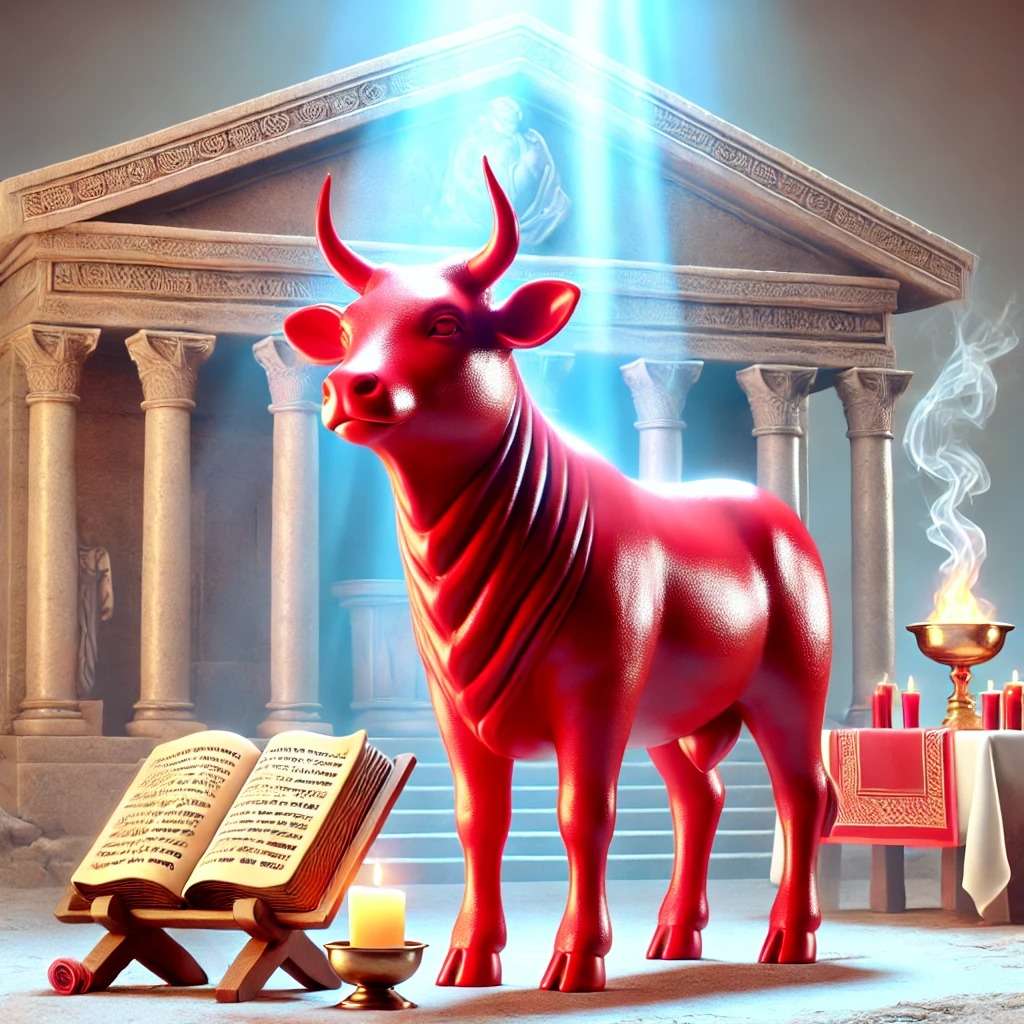
Curious about what does the Bible say about the red heifer? You’re not alone. This ancient and somewhat mysterious topic has intrigued scholars and believers for centuries. The red heifer isn’t just a footnote—it’s a key element in biblical teachings, especially when it comes to purity rituals.
In the Old Testament, specifically in the Book of Numbers, you’ll find detailed descriptions and specific requirements for this rare animal. But why does it matter today? Understanding its significance can offer deeper insights into biblical traditions and their lasting impact on modern faith practices. Dive in to explore how this seemingly obscure reference holds profound meaning even now.
What Does the Bible Say About the Red Heifer:
Historical Context of the Red Heifer
Origin in the Old Testament
The red heifer first appears in the Book of Numbers, Chapter 19. God instructs Moses and Aaron on its sacrificial use for purification rites. The heifer must be without blemish and never yoked, ensuring its purity.
Ritual Significance
Ancient Israelites used the ashes of a burnt red heifer to purify those who had contact with corpses. This ritual symbolizes cleansing from sin and death, highlighting the importance of purity in worship practices.
Symbolic Interpretations
Scholars suggest that the red heifer represents ultimate sacrifice and foreshadows Christ’s atonement. Its rarity underscores its unique role in biblical traditions, emphasizing God’s demand for perfection.
Modern Relevance
Understanding the historical context of the red heifer helps modern believers grasp biblical purity laws’ depth. This knowledge enriches faith practices by connecting ancient rituals to contemporary spiritual life.
Biblical References to the Red Heifer
The Bible contains several references to the red heifer, primarily in its Old Testament books. These references highlight its importance in purification rituals and foreshadow future theological concepts.
Understanding Old Testament Passages on the Red Heifer
In Numbers 19:1-10, God commands Moses and Aaron to use a red heifer for ritual purification. This passage details how an unblemished red heifer, without defect or yoke, must be slaughtered outside the camp. The ashes from this sacrifice mixed with water provide cleansing for those who have come into contact with death (Numbers 19:11-13). Another reference appears in Hebrews 9:13-14 which discusses how the blood of goats and bulls along with the ashes of a heifer sanctifies those who are ceremonially unclean.
Insights from New Testament Passages on the Red Heifer
While direct mentions of the red heifer are sparse in the New Testament, certain passages draw parallels to it. Scholars often link Hebrews 9:13-14 to Numbers’ ritual law by explaining that Christ’s sacrifice supersedes and fulfills these ancient rites. The author argues that if animal sacrifices could purify flesh temporarily, then Christ’s blood could cleanse one’s conscience permanently. This comparison enhances understanding of both Testaments’ continuity regarding sin and atonement practices.
Benefits of Knowing What Does The Bible Say About The Red Heifer
Understanding what does the Bible say about the red heifer deepens your comprehension of biblical themes related to purity and sacrifice. It connects ancient Israelite practices with modern spiritual life by illustrating God’s consistent demand for holiness through perfect offerings. Recognizing these connections helps foster a richer faith experience rooted in Scripture’s holistic narrative.
Significance in Jewish Tradition
Historical Understanding of the Red Heifer
The red heifer holds historical significance in Jewish tradition, rooted deeply in ancient texts. The Torah describes the ritual involving the red heifer as a unique purification process for those who have come into contact with death. Numbers 19:2 specifies that the animal must be “without defect and never yoked.” This rare requirement underscores its purity and special role.
Rituals and Symbolism
Rituals involving the red heifer were crucial for maintaining spiritual cleanliness. The ashes from its sacrifice were mixed with water to create a purification mixture used in various rites. This practice symbolized cleansing from impurity, an essential aspect of maintaining holiness within the community (Numbers 19:9). The symbolism extends to ideas of sacrifice and atonement, reflecting God’s demands for purity and perfection.
Modern Relevance
In modern times, some Jewish groups continue to study the laws concerning the red heifer. While no sacrifices are performed today due to the absence of a Temple, these studies highlight ongoing religious aspirations related to purity and redemption. Efforts by certain organizations aim to breed a perfect red heifer, which they believe is necessary for future rituals should a new Temple be built.
Impact on Spiritual Practices
Understanding what the Bible says about the red heifer can deepen your engagement with Jewish traditions. It links ancient practices with contemporary faith experiences, offering insights into themes of purification and sacrifice still relevant today. By studying these traditions, you connect more profoundly with historical aspects of faith while enriching your spiritual life through contextual comprehension of biblical narratives surrounding purity.
Interpretations and Symbolism
The red heifer holds deep symbolic meaning in biblical texts. It represents themes of purification, sacrifice, and redemption.
Purity and Cleansing
The red heifer’s primary role involves rituals of purity and cleansing. In the Book of Numbers 19:2-10, its ashes were mixed with water to create a purification solution for those defiled by contact with death. This process underscores the importance of maintaining spiritual cleanliness among ancient Israelites. The symbolism extends beyond physical purification, pointing to a deeper spiritual renewal necessary for approaching God.
Messianic Connections
The red heifer also bears messianic connections within Jewish eschatology. Some interpretations link it to future events foretold in prophetic scriptures. Many believe that finding an unblemished red heifer indicates the coming of the Messiah and the rebuilding of the Temple (Ezekiel 36:25). These connections imbue contemporary efforts to breed a perfect red heifer with significant religious meaning, signaling hope for ultimate redemption.
Benefits Of Understanding What Does The Bible Say About The Red Heifer
Understanding what the Bible says about the red heifer enriches your engagement with scriptural themes of purity, sacrifice, and redemption. By delving into these interpretations, you gain insights into ancient traditions that continue to influence modern faith practices. This knowledge enhances your spiritual life by connecting past rituals with present-day beliefs and aspirations toward holiness.
Modern Perspectives
Modern perspectives on the red heifer offer diverse insights across different faiths, reflecting evolving interpretations and theological significance.
Contemporary Jewish Views On The Red Heifer
Contemporary Jewish views on the red heifer focus on its role in eschatological events. Many Orthodox Jews believe that the birth of a flawless red heifer signifies impending significant religious milestones. Efforts persist to breed such an animal, highlighting ongoing religious enthusiasm and anticipation for rebuilding the Third Temple. For example, organizations like The Temple Institute actively search for a perfect red heifer, seeing it as essential for future purification rituals.
Christian Interpretations Of The Red Heifer
Christian interpretations of the red heifer often connect it to themes of sacrifice and foreshadowing Christ’s ultimate sacrifice. Some view it as a typology representing Jesus’ purity and his role in spiritual cleansing. In Hebrews 9:13-14, references to purification underscore this belief by drawing parallels between Old Testament rituals and Christ’s atonement. This perspective bridges ancient scriptural elements with foundational Christian doctrines about redemption and salvation.
Relevance Of The Red Heifer To Modern Faith Practices
The relevance of the red heifer extends to modern faith practices by symbolizing enduring themes of purity and redemption across religions. For Jews, it embodies hopes tied to messianic prophecies and temple restoration efforts. For Christians, it’s viewed through doctrinal lenses emphasizing Christ’s sacrificial purity. By understanding these perspectives, you gain deeper insight into how ancient biblical symbols continue influencing contemporary religious beliefs and practices.
Conclusion:
What Does the Bible Say About the Red Heifer?
Exploring the red heifer’s biblical significance reveals its profound impact on religious rituals and beliefs. From purification in ancient Israel to messianic expectations, this symbol of purity continues to resonate deeply across faiths. Whether you’re examining Jewish eschatology or Christian theology, the red heifer represents hope and spiritual renewal. Its enduring relevance highlights the timeless nature of these sacred themes, reminding you of the interconnectedness between historical traditions and modern religious practices. Understanding this can enrich your perspective on how biblical symbols shape contemporary faith experiences and beliefs.
Frequently Asked Questions:
What Does the Bible Say About the Red Heifer?
What is the historical significance of the red heifer in the Bible?
The red heifer holds historical importance as a symbol of purity used in ancient Israelite purification rituals, primarily mentioned in the Book of Numbers.
How was the red heifer used in ancient Israelite practices?
The red heifer was sacrificed and its ashes were used to create water for ritual purification, essential for maintaining spiritual cleanliness.
What does the red heifer symbolize?
It symbolizes purity, sacrifice, and redemption. It also signifies spiritual renewal necessary for approaching God.
Are there messianic connections associated with the red heifer?
Yes, within Jewish eschatology, it is believed that the birth of a flawless red heifer signals future events related to the coming of the Messiah.
Why are efforts being made today to breed a perfect red heifer?
Breeding a perfect red heifer carries significant religious meaning as it represents hope for ultimate redemption and future purification rituals.
How do contemporary Jewish views interpret the significance of the red heifer?
Orthodox Jews view its birth as indicative of impending religious milestones and continue efforts to breed an unblemished specimen for future rites.
What is the Christian perspective on the symbolism of the red heifer?
Christians often see it as foreshadowing Christ’s ultimate sacrifice and emphasize his role in spiritual cleansing akin to ritual purification by its ashes.
Is there modern relevance to ancient symbols like the red heifer in faith practices today?
Yes, these symbols continue to embody themes of purity and redemption across religions, influencing contemporary beliefs tied to messianic prophecies and doctrinal teachings about Christ’s sacrificial purity.

